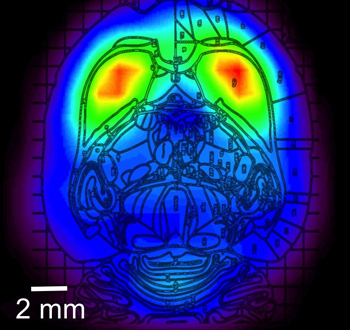Research Brief: If the Cap Fits...? Portable Scanners for Rodent PET
Quick Links
Scientists at Brookhaven National Laboratory in Upton, New York, have designed the “RatCAP,” a tiny positron emission tomography system for whole-brain imaging of freely moving rodents. As described in a paper published today in Nature Methods online, the researchers, led by senior investigator Paul Vaska and first author Daniela Schulz, used their portable 250-gram PET scanner, which fits onto the animal’s head, to monitor dopamine receptors in striatal neurons of awake, mobile rats injected with the 11C-labeled tracer raclopride (see image).

In this PET scan of a rat’s brain made with the RatCAP system, the rainbow scale (red = high, violet = low) indicates the level of radiotracer binding to dopamine receptors in the striatum. Image credit: Brookhaven National Laboratory
PET aficionados who study Alzheimer’s disease said the new technology could prove useful in animal models of motor function and learning. “The basic function of dynamic neurotransmitter systems in the presence of various amyloids or in normal aging could be studied this way, so I think this could well have an important impact in research in aging and neurodegenerative disorders,” noted Keith Johnson, Massachusetts General Hospital, Boston, in an e-mail to ARF.
Bill Jagust of the University of California, Berkeley, is excited about the possibility of scaling up the technology for human studies, to minimize the problem of subject motion during scans. Similar thoughts came to mind for Bill Klunk, who co-invented the amyloid tracer Pittsburgh Compound B (PIB) widely used for PET imaging studies of amyloid plaques in AD, and called the current study “an impressive technical tour de force.” In discussions with University of Pittsburgh colleagues, the scientists have envisioned making user-friendly “upright scanners in which our elderly subjects could sit in a chair as if under a huge, old-fashioned hair dryer,” Klunk noted. “This study suggests they don’t need to be so huge, perhaps.” Reisa Sperling of Brigham and Women’s Hospital, Boston, thinks the technology could someday be useful for tracking brain functional responses to anti-amyloid medications.—Esther Landhuis
References
No Available References
Further Reading
Papers
- Kirschenbaum F, Hsu SC, Cordell B, McCarthy JV. Substitution of a glycogen synthase kinase-3beta phosphorylation site in presenilin 1 separates presenilin function from beta-catenin signaling. J Biol Chem. 2001 Mar 9;276(10):7366-75. PubMed.
Primary Papers
- Schulz D, Southekal S, Junnarkar SS, Pratte JF, Purschke ML, Stoll SP, Ravindranath B, Maramraju SH, Krishnamoorthy S, Henn FA, O'Connor P, Woody CL, Schlyer DJ, Vaska P. Simultaneous assessment of rodent behavior and neurochemistry using a miniature positron emission tomograph. Nat Methods. 2011 Apr;8(4):347-52. PubMed.
Annotate
To make an annotation you must Login or Register.

Comments
No Available Comments
Make a Comment
To make a comment you must login or register.